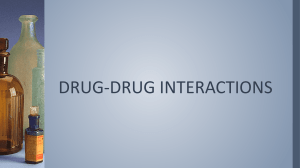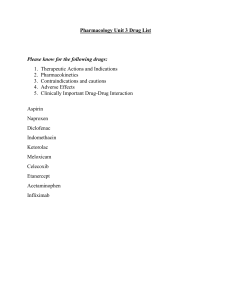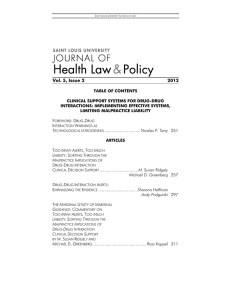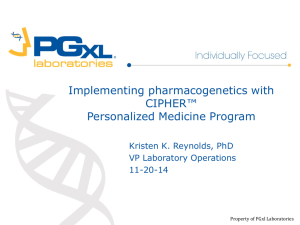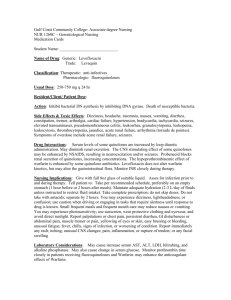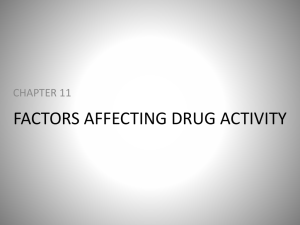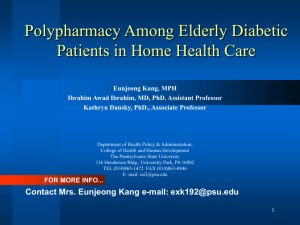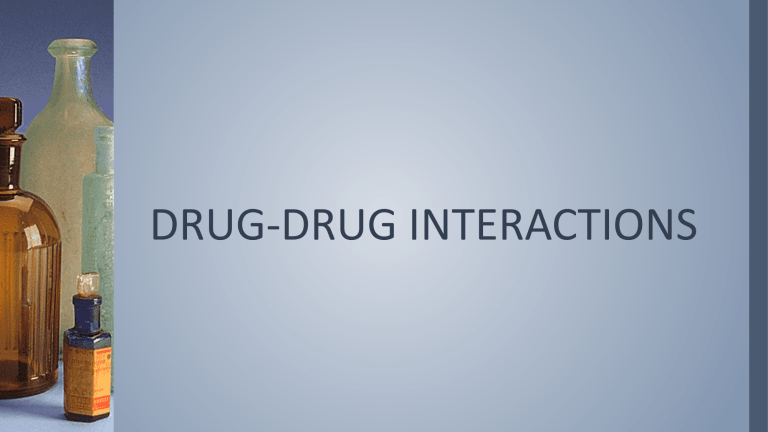
DRUG-DRUG INTERACTIONS Presented by: Afifa Zahid Anmol Shehzadi Maliha Tanveer Sada Fatima Presented to: Ma’am Zeemal Semaab CONTENTS › Drug–drug interactions › Probability of drug interaction › Top 10 drug-drug interactions › Types of drug-drug interactions › Pharmacokinetic interactions › Pharmacodynamics interactions DRUG–DRUG INTERACTIONS › Drug-drug interactions occur when two or more drugs react with each other. › This drug-drug interaction could give desirable/ beneficial effect and undesirable/harmful effect. › For example, mixing a drug you take to help you sleep (a sedative) and a drug you take for allergies (an antihistamine) can slow your reactions. › One example is the interaction between warfarin (Coumadin), an anticoagulant (blood thinner), and fluconazole (Diflucan), an antifungal medication. Taking these two drugs together can lead to a potentially dangerous increase in bleeding. › In some cases, however, some are stakeholders of the efficiency of the treatment and DDI strategy is exploited by some drug associations, including levodopa (L-Dopa) and dopadecarboxylase inhibitors, β-lactam antibiotics and clavulanic acid, 5-fluorouracil (5-FU) and folinic acid, and penicillin and probenecid. › More recently, some drug-drug combinations have been integrated in modern drug design strategies, aiming to enhance the efficiency of already marketed drugs with new compounds acting not only as synergistic associations, but also as real boosters of activity. › Harmful drug–drug interactions are important as they cause 10–20% of the adverse drug reactions requiring hospitalization and they can be avoided. › Elderly patients are especially vulnerable with a strong relationship between increasing age, the number of drugs prescribed and the frequency of potential drug–drug interactions. PROBABILITY OF DRUG INTERACTION › The Drug whose Activity is effected by such an Interaction is called as a “Object drug.” › The agent which precipitates such an interaction is referred to as the “Precipitant”. TOP 10 DRUG-DRUG INTERACTIONS › Warfarin ~ NSAIDs › Warfarin ~ Sulfa Drugs › Warfarin ~ Macrolides › Warfarin ~ Quinolones › Warfarin ~ Phenytoin › ACE Inhibitors ~ Potassium Supplements › ACE Inhibitors ~ Spironolactone › Digoxin ~ Amiodarone › Digoxin ~ Verapamil › Theophylline ~ Quinolones https://www.medindia.net/patientinfo/ten-common-drug-drug-interactions.htm Types of Drug-Drug Interactions › BEHAVIOURAL DRUG-DRUG INTERACTIONS: Altered compliance Behavioral drug–drug interactions occur when one drug alters the patient’s behavior to modify compliance with another drug. For example, a depressed patient taking an antidepressant may become more compliant with medication as symptoms improve. › PHARMACEUTIC DRUG-DRUG INTERACTIONS: Outside the body Pharmaceutic drug–drug interaction is a physicochemical interaction that occurs when drugs are mixed in I.V infusions causing precipitation or inactivation of active principles before it is administered. For example, precipitation of sodium thiopentone and vecuronium within an intravenous giving set. Example:-Ampicillin, chlorpromazine & barbiturates interact with dextran in solutions and are broken down or from chemical compounds. › PHARMACOKINETIC DRUG-DRUG INTERACTIONS: Altered concentration Pharmacokinetic drug–drug interactions occur when one drug changes the systemic concentration of another drug, altering ‘how much’ and for ‘how long’ it is present at the site of action. › PHARMACODYNAMIC DRUG-DRUG INTERACTIONS: Altered effect Pharmacodynamics drug–drug interactions occur when interacting drugs have either additive effects, in which case the overall effect is increased, or opposing effects, in which case the overall effect is decreased or even ‘cancelled out’ Mechanism: molecular signal (e.g. receptor) Mode: physiological effect
